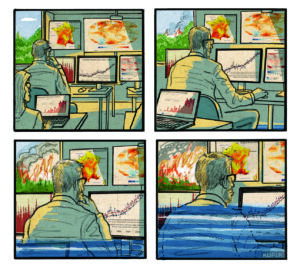‘Bomb Cyclone’ Storm Hammers Central U.S., Disrupting Travel
Blizzard warnings are posted from Colorado to Minnesota, and wildfires are a concern in New Mexico, Texas and Oklahoma.Blizzard warnings were posted from Colorado to Minnesota on Wednesday and wildfires were a concern in New Mexico, Texas and Oklahoma as the second so-called “bomb cyclone” storm in less than a month hit the central U.S., raising the prospect of renewed flooding in the already drenched Midwest.
Heavy snow began disrupting ground and air travel Wednesday afternoon. Roads became impassable and visibility was down to a few feet in northeastern South Dakota due to snowfall of up to 11 inches. About half of the daily flights at Denver International Airport were canceled.
Up to 2 ½ feet (0.61 meters) of snow was expected to fall in parts of eastern South Dakota and southwestern Minnesota, the National Weather Service said. Winds in excess of 50 mph (80.46 kph) also were expected, creating life-threatening conditions.
“We’re calling it historic because of the widespread heavy snow. We will set some records,” said Mike Connelly, a weather service meteorologist in Aberdeen, South Dakota.
Transportation officials closed Interstate 29 from east central South Dakota to the North Dakota border and said other stretches of major interstates were likely to close later as conditions deteriorated. Numerous traffic crashes were reported in northeastern South Dakota, though there were no immediate reports of serious injuries. Transportation officials in Colorado said highway closures also were likely in that state.
An unusual but not rare weather phenomenon known as “thunder snow” — snow accompanied by thunder and lightning — was reported in central South Dakota.
“It’s essentially a thunderstorm, but it’s cold enough for snow,” Connelly said.
South Dakota Gov. Kristi Noem closed state government offices in 52 counties. Numerous schools around the state closed, along with several Black Hills National Forest offices in western South Dakota and eastern Wyoming. Minnesota Gov. Tim Walz said “the National Guard stands ready” to rescue any stranded motorists.
The weather service posted an ice storm warning into Friday morning for a portion of southern Minnesota, saying up to three-fourths of an inch of ice could accumulate on power lines, leading to outages.
To the west, the looming spring blizzard in the Rockies was impacting flights, school classes, government functions and even baseball.
Major League Baseball’s Colorado Rockies postponed an afternoon game against the Atlanta Braves until August. A few school districts in Colorado and Wyoming canceled classes, while others opted for a shortened day and canceled evening activities. Local governments, including in Denver and Cheyenne, Wyoming, and state government in the Denver area closed offices early to give workers time to commute before conditions worsened.
Strong winds associated with the weather system were creating dangerous wildfire and travel conditions in New Mexico, Texas and Oklahoma. The weather service issued a high wind warning for the Texas and Oklahoma panhandles.
Winds in excess of 50 mph (80.46 kph) were combining with low humidity and an unstable atmosphere to create critical fire conditions in the three states. Forecasters in New Mexico said the winds also would make travel difficult on north-south oriented roads such as Interstate 25. In southern New Mexico, the U.S. Army’s White Sands Missile Range closed Wednesday because of the high winds.
The storm technically met the scientific definition of what’s commonly known as a “bomb cyclone,” said David Roth, a forecaster at the National Weather Service’s Weather Prediction Center in Maryland.
The weather phenomenon with a complex scientific definition essentially entails a rapid drop in air pressure and a storm strengthening explosively. What is more important than the term is the storm’s impacts, which are likely to be similar to last month’s storm , Roth said.
That blast dropped heavy snow and led to massive flooding in the Midwest that caused billions of dollars in damage in Nebraska, Missouri, Iowa and South Dakota.
“Hopefully this time it will be a slow snowmelt,” Roth said.
Forecasters said this week’s storm will swell rivers again, though likely not to the levels seen last month due to the absence of a wet snowpack on frozen ground this time around.
“We’re not out of the woods,” Walz said.
Even moderate rises in the Missouri River will push more water into drenched Fremont County in southwestern Iowa, Emergency Manager Mike Crecelius said. Last month’s flooding swamped 455 houses and thousands of acres of farmland in his region.
“The problem is that we’re not getting any time for the water to recede and things to dry out, so the levees can’t be fixed; houses can’t be fixed; crops can’t be planted,” he said. “And the last spring forecast I saw does not look favorable for us at all. It looks to be a very wet spring.”
___
Associated Press writers Colleen Slevin in Denver; Alan Clendenning and Danny Pollock in Phoenix; Margery Beck in Omaha, Nebraska; Tim Talley in Oklahoma City; and Steve Karnowski in St. Paul, Minnesota, contributed to this story.
Your support matters…Independent journalism is under threat and overshadowed by heavily funded mainstream media.
You can help level the playing field. Become a member.
Your tax-deductible contribution keeps us digging beneath the headlines to give you thought-provoking, investigative reporting and analysis that unearths what's really happening- without compromise.
Give today to support our courageous, independent journalists.









You need to be a supporter to comment.
There are currently no responses to this article.
Be the first to respond.